Join Chris Johnson as he recounts his experience conducting the Christmas Bird Count on Abaco just two months after Hurricane Dorian devastated the region. While the survey was a somber reminder of the destructive forces of nature and how much recovery is still needed, Chris and his team found hope and encouragement in the birds they encountered. #AbacoStrong
Abaco – my beloved island
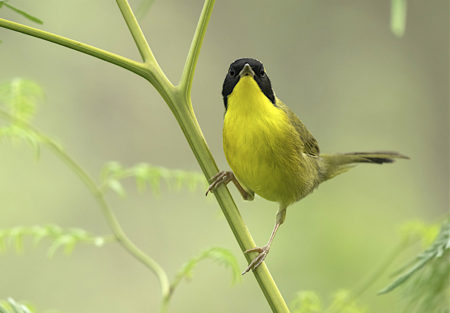
I have been bird-watching in Abaco, an island in the northern Bahamas, for a little over eleven years. Actually, Abaco is where I started birding at the age 7. Needless to say, Abaco is very near and dear to my heart. When Hurricane Dorian hit the island that I have so much love for, I was heartbroken. I could not begin to fathom how my favorite island would be changed forever.
The hurricane occurred in September 2019, and shortly after, I made a trip back to assist some family members. The destruction I saw was catastrophic and the numbers of bird species had declined dramatically. On December 7th, 2019 , I learned that there would be no annual Christmas Bird Count (CBC) for North and South Abaco. I asked fellow birder and mentor Dr. Elwood Bracey if there were any plans to conduct the CBCs on Abaco. I was distraught to learn that the two annual leaders – Dr. Bracey and Reg Patterson – would not be able to attend and assist in the conducting of these surveys. The Abaco CBCs are a yearly tradition for the past ten years; I was very disheartened. I thought it over and said to myself, “If there’s nobody else who can lead it… You have to do it!” I contacted my Abaco emailing list and began to “round up the troops” for the 2020 Abaco CBCs.
After I touched down in Marsh Harbour for the second time post-Dorian, I realized immense reconstruction had begun. Roofs were being replaced, trash was being hauled back and forth to the dumps, the roads had been cleared of debris, and the well-known Abaco food store, Maxwell’s, had reopened. Sadly, however, the resident bird life in Marsh Harbour was still immensely affected. During three hours in Marsh Harbour the only resident birds that were seen or heard were four Great Egrets; five Eurasian Collared-Doves (invasive species, now resident); and a Turkey Vulture.
The aftermath of Hurricane Dorian during one of the author’s visits showing the destruction of St. Francis De Sales Catholic School and defoliated trees. (Video by Chris Johnson)
At the end of the first day in Abaco, a gorgeous sunset peered through the pulverized pine barrens. It was a beautiful ending to the day; the South Abaco CBC would follow the very next day.
South Abaco Christmas Bird Count
I woke up on the morning of South Abaco CBC anxious for the day to come. I brewed my two cups of coffee and sat on the porch as I felt the 20 mile per hour winds roll through Cherokee Sound. My Uncle, Keith Kemp arrived at my grandfather’s house at around 6:30 a.m. so we could begin our journey south to “The Y” (a popular landmark in South Abaco) at the Abaco National Park. Along the way we collected fellow birder and leader for the South Count, Niles Primrose. Along the 28-mile drive from Cherokee Sound down to The Y, we discussed the team grouping and the leaders for each team. We all agreed that my uncle would lead the team going North of the Abaco National Park, Niles would lead the Sandy Point team and I would lead the Abaco National Park (Forest) team. We arrived at the meet-up spot for 7:30 promptly. At the Y we met our additional birding peers: Janene Roessler and Lavonda Smith. After catching up for a short time we were met by Bahamas National Trust (BNT) park warden Marcus Davis. As we discussed the plans for the day a resident Red-Tailed Hawk flew over the group. A great first bird for the Forest Team! With everyone assembled we split into our respective groups and went our separate ways.
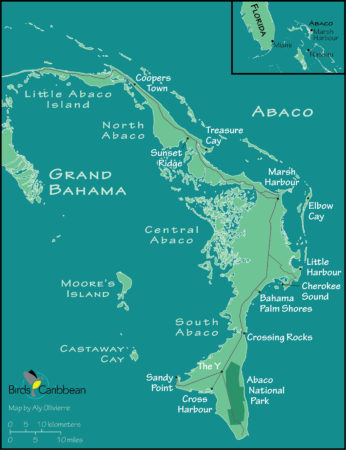
The forest team, consisting of Marcus Davis and myself, travelled into the forest armed with our binoculars, field guides and one oversized camera to count all the bird species that we could possibly find. The first species that we saw was a male Cuban Emerald, fluttering around some morning glory flowers. He was eventually chased away from his routine pollination job by another Cuban Emerald, who also wanted a taste of the nectar. As we continued traversing the forest, we were listening closely for some Bahamian specialties such as the Bahama Warbler and Olive-capped Warbler. The next bird of interest was a Yellow-bellied Sapsucker hard at work on drilling into a Caribbean Pine Tree.
The sapsucker, who was reaping rewards from his task of drilling into the dense pine tree, became “antsy” very quickly. Before our eyes the bird was under attack from another species of the raptor family. A Merlin had seemingly dropped out of the sky to attempt to catch the apsucker for a meal. However, the plot had failed and the Merlin decided to sit on a long pine branch. After a great photo-op, the small falcon decided that enough was enough and he was back on the hunt. He began coasting along the track road that appeared unaffected by Dorian, awaiting another opportunity for prey to present itself.
A Resilient Abaco National Park
As we journeyed deeper into the National Park, Marcus began to explain how lucky South Abaco was. It was minimally affected by Hurricane Dorian. And the numbers, even within the pine forest, were proving this statement. As we continued our conversation, a vivacious song filled the forest. Not one, not two, but three Pine Warblers flew into the pine right in front of our vehicle. The bright yellow warblers flew onto the bark of the pines, flitting about and dropping into the understory. After these warblers, we saw an Abaco and Grand Bahama specialty bird. The tiny and long-tailed Olive-capped Warblers maneuvered through the large pine tree tops, singing and chirping. The show continued for another ten minutes as we watched the tiny warblers ramble about the pine forest.
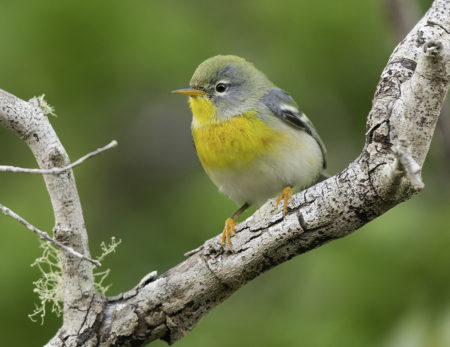
Forty minutes in and we were already up to 17 species. However, we were still missing a few species. The Bahama Warbler, a relative of the North American Yellow-throated Warbler was finally seen for the first time of the day clinging onto the bark of the large pine trees and moving transversely. I decided to use a playback of a Bahama Warbler in an attempt to coax the fascinating warbler out. The explosive song from the pint-sized warbler began to ring out from within the forest. 1..2..3..4..5..6..7… seven Bahama Warblers flew into the pines directly in front of Marcus and me. What a sight to see! All of these warblers congregated together even after Hurricane Dorian.
After many more encounters with the Bahamian specialties, we began to spot and note many more migrant and winter resident species. Some of these species’ behavior and feeding habits had definitely changed thanks to Hurricane Dorian. For example, I noted a group of Indigo Buntings hopping about and feeding along the quarry road, something I had not seen in my ten-plus years of birding. Many birds were also grouped together, something quite abnormal for the time of year. One by one winter residents began to appear: Black-and-white Warblers, Northern Parulas, Yellow-throated Warblers, American Redstarts, Common Yellowthroats and an abundance of Palm Warblers.
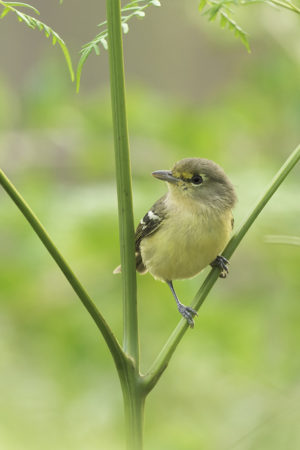
We eventually arrived at Cross Harbour to begin counting some water birds and shorebirds. Upon arrival at Cross Harbour, we were greeted by two new species. Sticking to each other very closely were a Yellow-rumped Warbler of the Myrtle variety and a Cuban Pewee. Both concentrated on catching insects for a quick meal. With all of the wind on the shorefront, catching bugs would prove to be a difficult task.
As Marcus and I traversed the seemingly endless beach and shore we also spotted new species! Three new herons and egrets had positioned themselves on the beach to begin fishing for their food. The species included a Yellow-crowned Night-Heron, Reddish Egret and a Great Egret. The tiny “tail-bobbing” Spotted Sandpiper decided to make an appearance for the day as it foraged on the shorefront for any small crustaceans that it could fit its beak around.
Along the trail which would eventually lead back to “The Y”, I noticed that we had not seen any species of dove for the day. The Common Ground Doves and Zenaida Doves, which were usually plentiful on the track roads, were now few and far between.
We eventually arrived back at “The Y” and arranged with the other teams to count all the bird species – as well as make time for a group picture in front of the Bahamas National Trust’s Abaco National Park sign! By the time everything was said and done the South count had totaled 62 species on the day of CBC and 67 species after count week. *Count week is the period of time before and after the day of CBC*. The numbers for the South were great post-Dorian as in past years the total number of birds were sometimes over 70.
POST CBC TRIP TO Bahama Palm Shores
After the CBC information was gathered and shared amongst ourselves, we all parted ways and returned back to our homes. I had decided that I just did not get enough birding during the CBC and decided to head to Bahama Palm Shores (BPS). I started off the checklist by stopping near a large patch of coppice. There was a dead tree trunk with dead branches still attached. Upon “pishing” for a few minutes, four Magnolia Warblers appeared. They put on a show by approaching me and got within three feet! The other species that made themselves known were Greater Antillean Bullfinches, Red-legged Thrushes, Blue-gray Gnatcatchers and an abundance of Northern Parulas.
As I was just about to wrap up, I heard a vociferous chatter and calling near the easternmost street within Bahama Palm. I knew the chatter well; it was the species that got me started on bird-watching. The Bahama / Cuban Amazon Parrot had established a small population within BPS. I counted a total of more than 45 parrots in that particular area. This was abnormal, as I had never seen a group of more than thirty parrots in Bahama Palm Shores. They all appeared healthy and were actively feeding on Gum Elemi berries. Within the hour and four minutes I had spent at Bahama Palm Shores I had a total of 26 species and 114 individuals sighted (see the full eBird checklist here).
North Abaco Christmas Bird Count
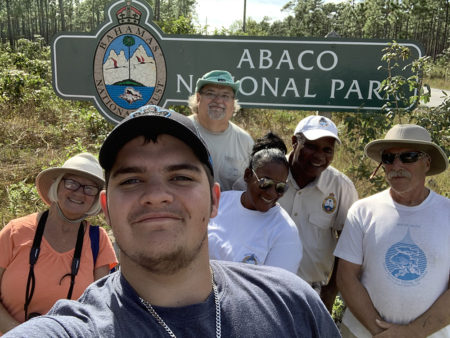
The morning of the North Abaco CBC started much like the previous morning. I started brewing my coffee and sat on the porch. This morning was much cooler than the morning of the South Abaco CBC. My Uncle Keith Kemp arrived at the house packed and ready for the day. We jumped in the truck and proceeded to the road that connects Cherokee to the Great Abaco Highway. There at the “turnoff” (the road where the Cherokee and Great Abaco Highway meet) we collected birding buddy Janene Roessler, who would be our scribe for the day.
As we began to inch closer towards Treasure Cay on the S.C. Bootle Highway, we witnessed a bizarre number of Great Egrets grouped in the ruinous wetland. There was a total of 14 Great Egrets in this one area and that was it. No Common Gallinule, Coots, Grebes, or any herons in sight. It was heartbreaking to see the damage to the North; it was undoubtedly worse than the catastrophe that struck Marsh Harbour in Central Abaco.
We arrived at the original meeting point for all the previous North counts. “Spanky’s Parking Lot” was located within Treasure Cay. It was almost unrecognizable, if not for the large liquor store, which was still standing but had lost all of its windows during the storm. The damage at “Spanky’s” would be minuscule compared to the damage within Treasure Cay.
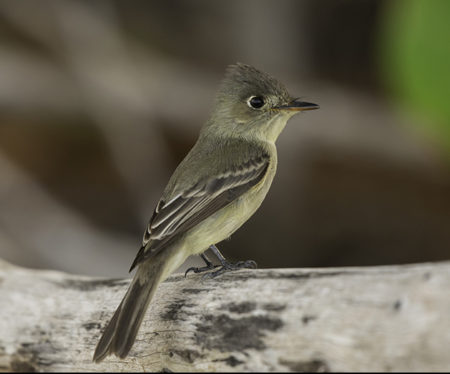
The first location would be to stop at the waterfront gas station to assess the damage the storm had done to the pylons and small rocky shorefront. After some substantial searching with our binoculars assisted by my 200-500mm camera lens we were able to pick up the first birds for the North Abaco CBC. We found: one Ring-billed Gull, one Black-bellied Plover, one Short-billed Dowitcher, and two Royal Terns.
We meandered our way through the debris-covered roads and paths for the next half hour with our destination in mind. My uncle had always spoken about a sandbank at the eastern end of Treasure Cay that always had birds. On our way out to the beach we were shocked to see Indigo Buntings perched low to the ground in dead shrubs foraging for food. The sandbank tragically held nothing for the count and we continued within the easternmost point. The damage at this end of the settlement was extraordinary. We saw entire “seawalls” washed out by the storm, houses seemingly torn in half, and cars flipped upside down.
Months after the hurricane, forests (like this one near Treasure Cay) have only begun to recover, and it will be years before they are able to support the same biodiversity as before the storm. (Video by Chris Johnson)
The next location was the Treasure Cay Golf Course Ponds. Many species had been counted on these small ponds in previous years. This area was by far our most active for the day. Our most notable species in this area were: White-cheeked Pintails, Least Grebes, Cattle Egrets, Merlin, White-eyed Vireo and the prize bird of the day… a Hooded Merganser! We noted quite a few new species for the count – but the storm-ravaged ponds and golf course were quite distressing to see.
The last few locations that we would check proved extremely disappointing. Sunset Ridge was a famed birding spot within Treasure Cay. Species ranging from Roseate Spoonbills to American White Pelicans, to the extremely rare Bald Eagle sighted by Dr. Bracey for many years had been recorded there. However, hope began to dwindle for the Dorian-devastated wetland. With the assistance of my camera we came to add a few more species to the “slowly-but-surely” growing list. One Belted Kingfisher, two Reddish Egrets, three Little Blue Herons, – and peculiarly enough, another large group of Great Egrets: a total of 26 individuals!
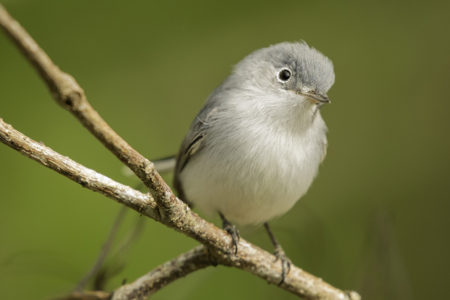
We then decided it would be in our best interest to make our way to Cooper’s Town foreshore to count some gulls and cormorants. Our trip to the foreshore allowed us to add numerous species to the list. It included: 25 Double-crested Cormorants, 18 Laughing Gulls, 11 Ring-billed Gulls, 4 Herring Gulls, 7 Lesser Black-backed Gulls and 1 Great Black-backed Gull!
At the end of the count, we had a total of 43 species for the North. This 2019 total was frightening as in previous years we would sometimes have totals of over 90 species. The number of species was effectively cut by fifty percent.
Final Thoughts
We all know that Dorian has done irreversible damage to Abaco. I would have never thought that such damage could be done to my second home. The catastrophic damage on this island is heartbreaking. The population counts are proving that we have not only lost many birds in the storm, but that birds in Abaco are still struggling to find food and shelter post-Dorian. There are many ways we can assist this Bahamian island in the rebuilding and replenishing of habitat for these avian species that make their home there. BirdsCaribbean and the Bahamas National Trust have done, and continue to do fantastic work in supporting research and replenishment of both Abaco and Grand Bahama. If you would like to assist these organizations in their efforts, please donate to the BirdsCaribbean Hurricane relief fund or The Bahamas National Trust.
Abaco and Grand Bahama will come back in time, and hopefully the birds with them. #AbacoStrong
Hover each photo to see the caption; click on a photo to see a slide show.
Chris Johnson is an avid 18-year-old birder and photographer. He has been birding for over 10 years and has gotten opportunities to further his birding skills namely the Cornell Lab of Ornithology’s Young Birder Event. He enjoys spending his time on many Bahamian family islands and photographing the fauna around him. You can find him on Instagram @cmjphotography242 to see more photos from this young photographer and birder.
Articles on Hurricane Dorian:
After Hurricane Dorian, An Emotional Birding Trip on Grand Bahama
Hurricane Dorian Recovery: An Update on How Our Appeal Funds Are Being Used
Help Us Heal the Devasting Impact of Hurricane Dorian in The Bahamas
Additional videos of Abaco habitats post-Dorian taken during December 2019 CBC by Chris Johnson





